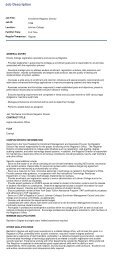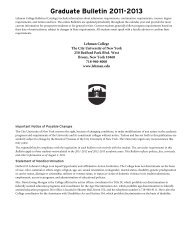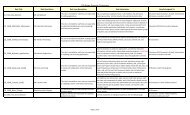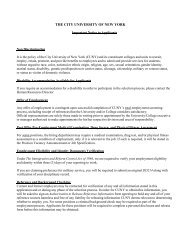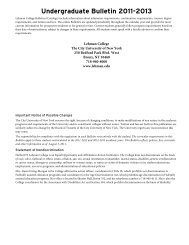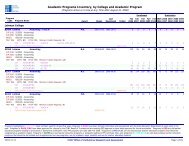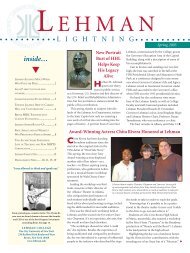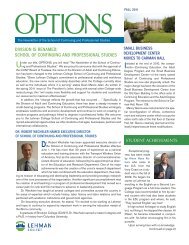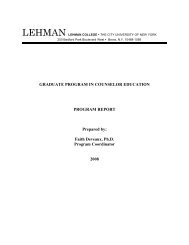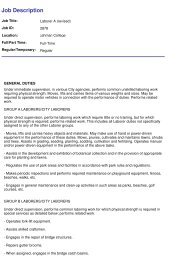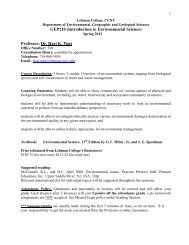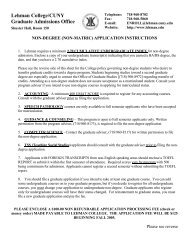Entering a New Era of Multimedia - Lehman College
Entering a New Era of Multimedia - Lehman College
Entering a New Era of Multimedia - Lehman College
You also want an ePaper? Increase the reach of your titles
YUMPU automatically turns print PDFs into web optimized ePapers that Google loves.
F A C U L T Y R E S E A R C H<br />
<strong>Lehman</strong> faculty are...<br />
Revealing an unseen role <strong>of</strong> critical<br />
care nurses<br />
The patients suffered from a range<br />
<strong>of</strong> ailments—caused by multiple gunshot<br />
wounds, hemorrhagic stroke,<br />
or emphysema complicated by drug<br />
use. What they had in common was<br />
where they all wound up: in Critical<br />
Care at St. Barnabas Hospital in the<br />
Bronx. That’s where they encountered<br />
Dr. Brigitte Cypress (Nursing).<br />
Over the course <strong>of</strong> almost six<br />
months in 2008, Pr<strong>of</strong>essor Cypress<br />
(‘04, M.S.) painstakingly interviewed<br />
the critical care nurses who<br />
Pr<strong>of</strong>essor Brigitte Cypress,<br />
right, with Martin LaVille.<br />
looked after them, the patients’ families and—when they were well<br />
enough—the patients themselves.<br />
The results <strong>of</strong> her interviews—a paper called “The Meaning <strong>of</strong><br />
Intensive Care Unit Experience as Perceived by the Nurses, Patients,<br />
and Family Members”—provides intriguing insights into the<br />
bedside dynamic <strong>of</strong> the nurses, the critically ill, and their families<br />
and has made quite a splash in the world <strong>of</strong> critical care nursing.<br />
Dr. Cypress presented her work at last year’s Roy Adaptation Association<br />
research workshop and conference in Boston, where she<br />
was awarded the <strong>New</strong> Scholar Award, and in February at the annual<br />
International Research Conference in Nursing and Midwifery,<br />
sponsored by the venerable Royal <strong>College</strong> <strong>of</strong> Surgeons in Dublin.<br />
In March, she presented the paper again at the Eastern Nursing<br />
Research Society in Providence, R.I. And in May her peers<br />
at the American Association <strong>of</strong> Critical-Care Nurses Exposition<br />
in Washington, D.C., heard her findings. In fact, the group awarded<br />
her its $10,000 Phillips Medical Outcomes Excellent Research<br />
Grant last year.<br />
Dr. Cypress grew up in the Philippines and earned her bachelor’s<br />
in nursing there before coming to the United States in 1991. For<br />
her, the study, which she categorizes as a qualitative—rather than<br />
quantitative—look at critical care issues, contained some surprises.<br />
When she broke down her questions into various categories,<br />
touching on subjects like physical care, psychological states, and<br />
the transformational possibilities <strong>of</strong> such a traumatic experience,<br />
she found that “patients, family members, nurses—they all said the<br />
same things.”<br />
So similar were the responses that she was able to limit her<br />
sample, thanks to what’s called “data saturation”—the happy tipping<br />
point where a researcher realizes that further effort will simply<br />
duplicate what’s already been done. “For instance,” she says,<br />
“patients uniformly referred to their brush with death as ‘a wakeup<br />
call,’ or ‘the longest day <strong>of</strong> my life.’ And all <strong>of</strong> them said, in one way<br />
or another: ‘I’m just so thankful to be alive.’”<br />
F A C U L T Y R E S E A R C H<br />
Dr. Cypress found, too, that each and every nurse saw himself<br />
or herself first <strong>of</strong> all as an advocate for the ailing patient and the<br />
worried family.<br />
Perhaps, most surprising, however, when Dr. Cypress interviewed<br />
family members, she found that, in the time their loved one spent<br />
in Critical Care, they very quickly ceased to look at the nurse as a<br />
detached giver <strong>of</strong> care. Instead, in their eyes, the nurse became,<br />
however briefly, one <strong>of</strong> them, a member <strong>of</strong> the family.<br />
Educating the public about nutrient<br />
supplements<br />
Sales <strong>of</strong> nutritional supplements in the<br />
United States total $23.7 billion. But<br />
<strong>of</strong>ten the consumers making those<br />
purchases are not really informed about<br />
what they’re buying.<br />
— Michael Neill<br />
Dr. Andrea P. Boyar, chair <strong>of</strong> Health<br />
Sciences at <strong>Lehman</strong> and director <strong>of</strong> its<br />
Dr. Andrea Boyar<br />
Dietetics, Food, and Nutrition program,<br />
coauthored a national position paper last year about both the<br />
effectiveness <strong>of</strong> these supplements and their potential dangers<br />
if used to excess. Written with fellow registered dietician Melissa<br />
V. Marra, the article was published in the December issue <strong>of</strong> the<br />
American Dietetic Association Journal and represents the ADA’s<br />
newly updated position on the subject.<br />
According to the authors, while additional nutrients from<br />
supplements can help some people meet their nutrient needs,<br />
the best nutrition-based strategy for supporting optimal health<br />
and reducing the risk <strong>of</strong> chronic disease is to eat a wide variety<br />
<strong>of</strong> nutrient-rich foods.<br />
Purchase <strong>of</strong> supplements, they said, is driven by “the aging <strong>of</strong><br />
the population and consumer desire to maintain good health and<br />
prevent disease,” and can be helpful to some in filling dietary gaps.<br />
They remind the public, however, that registered dietitians are the<br />
ones with “the knowledge and experience to educate consumers<br />
on safe and appropriate selection and use <strong>of</strong> supplements.”<br />
— Christina Dumitrescu<br />
Shattering accepted thinking about the<br />
ancient Maya<br />
Dr. Cameron L. McNeil (Anthropology) shattered accepted scientific<br />
thinking last December when she argued in Proceedings <strong>of</strong><br />
the National Academy <strong>of</strong> Sciences that large-scale deforestation<br />
did not cause the collapse <strong>of</strong> the ancient Maya city <strong>of</strong> Copan in<br />
Honduras, as many had believed.<br />
Copan has been widely used and promoted as the archeological<br />
“type site”—or model—for the deforestation hypothesis. After<br />
analyzing a longer sediment core than the one used to support that<br />
<strong>Lehman</strong> Today/Spring 2010 35




